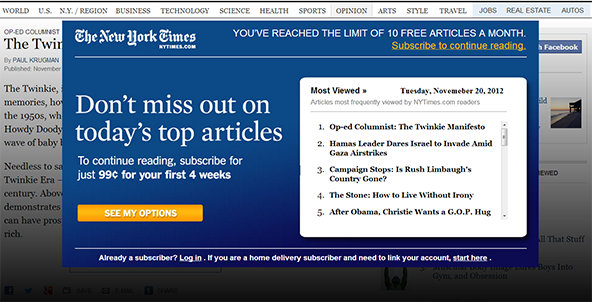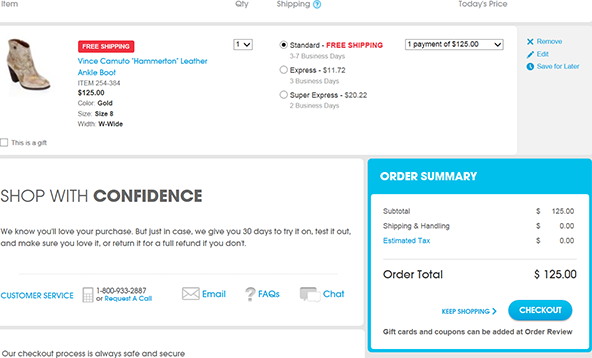Could Micropayments Rescue Journalism?

Update: On cue, the Economist has produced a chart that illustrates the impact of online subscriptions on the Wall Street Journal’s and the New York Times’ overall paid circulation. Both publications have enjoyed a marked improvement, but the uptick has been especially spectacular in the case of the NYT. See the chart below.
That is a question pondered by the BBC’s Dave Lee in an article for the broadcaster’s website. It is an interesting topic and one that has been hashed out for well over a decade, as the author himself points out. The idea is that the best way to monetize online content could be not by hiding it behind paywalls and requiring people to subscribe for it, as it is done by a number of big-name publications like the New York Times and the Financial Times, but to sell the content on a piecemeal basis. So, if having read the opening paragraph of an online article on a website employing the micropayment model, you would want to read the whole thing, you could get instant access by paying, say, $0.20 for it. Crucially, the model’s proponents argue, for the whole thing to work, the payment itself needs to be a quick and straightforward affair, so as not to put off the potential reader / customer.
And yet, for all its alleged benefits to everyone involved in the transaction, the micropayment model is yet to take off, whereas the subscription model is now fairly well established and accepted. Of course, not every publication which tried it managed to turn its online readers into paid subscribers — in fact there were more failures than successes — but what the experience tells me is that it is the content quality that matters more than the monetization model. As far as I can tell, all publications that are perceived to provide high-quality content did manage to find a way to get paid online. And I think there is a reason why all of them opted for the subscription model.
The Case for Micropayments
To make the case for micropayments, Lee enlists the help of Jakob Nielsen — a longtime proponent who, we are told, predicted back in 1998 that “most sites that are not financed through traditional product sales will move to micropayments in less than two years”. Needless to say, Nielsen’s prediction fell somewhat short of the reality, a rather spectacular misjudgment he explains with the lack of a “centralised initiative”. If only micropayments could be seen as a “popular choice among readers”, Nielsen argues, the whole concept would “take off”. It is a chicken-and-egg-type of problem, Nielsen tells us, and if only people started paying for it, the model would become profitable. Am I the only one having fun with his reasoning?
But it gets even more bewildering. Nielsen argues that now we finally have the payment infrastructure needed to push micropayments above the relevance threshold. Google Wallet allows users to quickly and painlessly pay for the online articles they want to read, he tells us, adding that it “is a seamless, one-click transaction — a world away from a lengthy sign-up process”. Well, for one, we have had such a simple payment option for more than a decade and its name is PayPal. More importantly, however, Nielsen assumes that the deciding factor in a user’s buying decision is convenience, whereas the evidence seems to strongly suggest that it is the perceived content quality.
Why the NYT and FT Can Do It, while Others Cannot?
As I already mentioned, and as Nielsen himself acknowledges, many big-name newspapers have managed to implement an online monetization strategy, with various degrees of success. The NYT seems to have met with more success than others, but even where the strategy has produced more modest results — Nielsen gives the Times of London as an example — the publishers have decided to stick to it all the same. Moreover, in all cases it is a subscription-based, not a piecemeal project. And that makes perfect sense to me. Most of us have our favorite sources of news and entertainment, which we visit every day. So it would make much more sense to subscribe for these websites and then just get in and out as often as you please, rather than having to pay for each individual piece of content you want to view.
Now, perhaps an argument could be made that a subscription-based model might work for the WSJs and Economists of the world, but not for smaller outlets that lack the brand name needed to attract a high-enough number of subscribers to make the proposition a viable one. But why should it be any easier for such websites to convince visitors to make a one-time payment, simple as it may be? After all, it is unlikely that smaller websites would buck the trend and attempt to charge first-time visitors for their content. And if they did, how many first-time visitors would be likely to buy content whose quality is unknown? Instead, publishers are likely to adopt the tested strategy of offering the first, say, ten or twenty views each month for free. But then, if someone visits your website that often, it is far more likely that she would find a subscription to be the more convenient — and cheaper — option than piecemeal payments. So I just don’t see a place for the one-time payment strategy.
Here is how the WSJ and the NYT have benefited from their subscription models:
It surely looks like both the WSJ and especially the NYT have discovered the right formula.
The Takeaway
This is not the first time an argument has been advanced that Google Wallet, and more broadly mobile payments, would make a difference simply because these new technologies are making it much simpler for users to make payments. And for some industries that is indeed the case. For example, a one- or two-click payment process does lead to higher conversion rates in both traditional online and mobile commerce environments. However, selling the content of a blog or a news website is not at all the same as selling a ringtone or an app and requires a different strategy.
Image credit: The New York Times.



At Kachingle we’ve combined micropayments and subscriptions.
As Cynthia mentioned above, there are systems that offer a combination of several monetization models.
Our Znak it!, for example, has been successful with a three-pronged approach where users have a choice of weekly/monthly subs, on-demand micropayments for individual content as well as ad-sponsored access. The methods do not cannibalize one another — to the contrary, when used concurrent, they generate conversion rates approaching 20%.
Check it out here: http://bit.ly/MpKXY2
I never pay for the things I read and always find ways around paywalls, including NYTs. These days people expect to read stuff for free and that’s not changing anytime soon.
A paywall is a badge of honor for a website. Everyone expects content to be free and so when a website starts charging a fee for its content, people take a closer look at it.